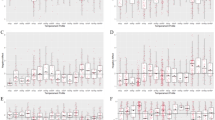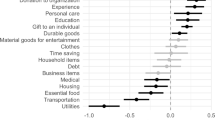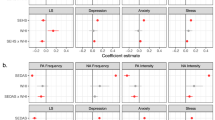Abstract
Contemporary approaches examining the determinants of happiness have posited that happiness is determined bidirectionally by both top-down, global life satisfaction and bottom-up, domain satisfaction processes. We propose a personalized happiness perspective, suggesting that the determinants and consequences of happiness are idiographic (that is, specific) to each individual rather than assumed to be the same for all. We showed the utility of a personalized happiness approach by testing associations between life and domain satisfaction at both the population and personalized levels using nationally representative data of 40,074 German, British, Swiss, Dutch and Australian participants tracked for up to 33 years. The majority of participants (41.4–50.8%) showed primarily unidirectional associations between domain satisfactions and life satisfaction, and only 19.3–25.9% of participants showed primarily bidirectional associations. Moreover, the population models differed from personalized models, suggesting that aggregated, population-level research fails to capture individual differences in personalized happiness, showing the importance of a personalized happiness approach. Patterns of individual differences are robust, yet distinguishing between individual-level patterns and random error is challenging, highlighting the need for future work and innovative approaches to study personalized happiness.
This is a preview of subscription content, access via your institution
Access options
Access Nature and 54 other Nature Portfolio journals
Get Nature+, our best-value online-access subscription
$32.99 / 30 days
cancel any time
Subscribe to this journal
Receive 12 digital issues and online access to articles
$119.00 per year
only $9.92 per issue
Buy this article
- Purchase on SpringerLink
- Instant access to full article PDF
Prices may be subject to local taxes which are calculated during checkout






Similar content being viewed by others
Data availability
Each data source was drawn from publicly accessible longitudinal studies. However, data cannot be shared directly due to contractual obligations and agreements necessary to use the data. In the text and online materials, we provide detailed information on how to gain access to raw data sources. All data analysis was conducted on the raw data files provided by the data maintainers, and all the utilized variables are documented in detailed in the study codebook. For GSOEP data, see https://www.diw.de/en/diw_01.c.601584.en/data_access.html; for BHPS, https://www.iser.essex.ac.uk/bhps/about/latest-release-of-bhps-data; for SHP, https://forsbase.unil.ch/project/study-public-overview/15632/0/ for HILDA, https://melbourneinstitute.unimelb.edu.au/hilda/for-data-users; and for LISS, https://liss.statements.centerdata.nl/.
Code availability
All code, results, tables and figures are available on the Open Science Framework (https://osf.io/r7vgq/) and GitHub (https://github.com/emoriebeck/personalised-happiness) and depicted in an interactive R Shiny web app (https://emoriebeck.shinyapps.io/personalised-happiness/). All scripts proceed from raw data that can be attained by downloading data files from the maintainers for each sample.
References
Beck, E. D. & Jackson, J. J. A mega-analysis of personality prediction: robustness and boundary conditions. J. Pers. Soc. Psychol. 122, 523–553 (2022).
Lyubomirsky, S., King, L. & Diener, E. The benefits of frequent positive affect: does happiness lead to success? Psychol. Bull. 131, 803–855 (2005).
Diener, E., Oishi, S. & Lucas, R. E. National accounts of subjective well-being. Am. Psychol. 70, 234–242 (2015).
Beck, E. D. & Jackson, J. J. Consistency and change in idiographic personality: a longitudinal ESM network study. J. Pers. Soc. Psychol. 118, 1080–1100 (2020).
Beck, E. D. & Jackson, J. J. Idiographic traits: a return to Allportian approaches to personality. Curr. Dir. Psychol. Sci. 29, 301–308 (2020).
Diener, E. Subjective well-being. Psychol. Bull. 95, 542–575 (1984).
Feist, G. J., Bodner, T. E., Jacobs, J. F., Miles, M. & Tan, V. Integrating top-down and bottom-up structural models of subjective well-being: a longitudinal investigation. J. Pers. Soc. Psychol. 68, 138–150 (1995).
Heller, D., Watson, D. & Ilies, R. The role of person versus situation in life satisfaction: a critical examination. Psychol. Bull. 130, 574–600 (2004).
Kuykendall, L., Tay, L. & Ng, V. Leisure engagement and subjective well-being: a meta-analysis. Psychol. Bull. 141, 364–403 (2015).
Jebb, A. T., Tay, L., Diener, E. & Oishi, S. Happiness, income satiation and turning points around the world. Nat. Hum. Behav. 2, 33–38 (2018).
Kahneman, D. & Deaton, A. High income improves evaluation of life but not emotional well-being. Proc. Natl Acad. Sci. USA 107, 16489–16493 (2010).
Helliwell, J. F., Huang, H., Norton, M., Goff, L. & Wang, S. in World Happiness Report 2023 11th edn (eds Helliwell, J. F. et al.) Ch. 2 (Sustainable Development Solutions Network, 2023).
Andrews, F. M. & Withey, S. B. Social Indicators of Well-Being: Americans’ Perceptions of Life Quality (Springer, 1976).
Campbell, A., Converse, P. E. & Rodgers, W. L. The Quality of American Life: Perceptions, Evaluations, and Satisfactions (Russell Sage Foundation, 1976).
Deaton, A. The financial crisis and the well-being of Americans: 2011 OEP Hicks Lecture. Oxf. Econ. Pap. 64, 1–26 (2012).
Nakazato, N., Schimmack, U. & Oishi, S. Effect of changes in living conditions on well-being: a prospective top-down bottom-up model. Soc. Indic. Res. 100, 115–135 (2011).
Diener, E. & Lucas, R. E. in Well-Being: The Foundations of Hedonic Psychology (eds Kahneman, D. et al.) 213–229 (Russell Sage Foundation, 1999).
Brickman, P., Coates, D. & Janoff-Bulman, R. Lottery winners and accident victims: is happiness relative? J. Pers. Soc. Psychol. 36, 917–927 (1978).
Brickman, P. & Campbell, D. T. in Adaption-Level Theory (ed. Appley, M. H.) 287–301 (Academic, 1971).
Diener, E., Lucas, R. E. & Scollon, C. N. in The Science of Well-Being: The Collected Works of Ed Diener (ed. Diener, E.) 103–118 (Springer, 2009); https://doi.org/10.1007/978-90-481-2350-6_5
Arvey, R. D., Bouchard, T. J., Segal, N. L. & Abraham, L. M. Job satisfaction: environmental and genetic components. J. Appl. Psychol. 74, 187–192 (1989).
Bartels, M. Genetics of wellbeing and its components satisfaction with life, happiness, and quality of life: a review and meta-analysis of heritability studies. Behav. Genet. 45, 137–156 (2015).
Ilies, R. & Judge, T. A. On the heritability of job satisfaction: the mediating role of personality. J. Appl. Psychol. 88, 750–759 (2003).
Lykken, D. & Tellegen, A. Happiness is a stochastic phenomenon. Psychol. Sci. 7, 186–189 (1996).
Stubbe, J. H., Posthumn, D., Boomsma, D. I. & De Geus, E. J. C. Heritability of life satisfaction in adults: a twin-family study. Psychol. Med. 35, 1581–1588 (2005).
Ludwig, J. et al. Neighborhood effects on the long-term well-being of low-income adults. Science 337, 1505–1510 (2012).
Luechinger, S. Valuing air quality using the life satisfaction approach. Econ. J. 119, 482–515 (2009).
Bolier, L. et al. Positive psychology interventions: a meta-analysis of randomized controlled studies. BMC Public Health 13, 119 (2013).
White, C. A., Uttl, B. & Holder, M. D. Meta-analyses of positive psychology interventions: the effects are much smaller than previously reported. PLoS ONE 14, e0216588 (2019).
Bialowolski, P. & Weziak-Bialowolska, D. Longitudinal evidence for reciprocal effects between life satisfaction and job satisfaction. J. Happiness Stud. 22, 1287–1312 (2021).
Judge, T. A. & Watanabe, S. Another look at the job satisfaction-life satisfaction relationship. J. Appl. Psychol. 78, 939–948 (1993).
Gana, K. et al. Relationship between life satisfaction and physical health in older adults: a longitudinal test of cross-lagged and simultaneous effects. Health Psychol. 32, 896–904 (2013).
Lucas, R. E. Top-down and bottom-up models of life satisfaction judgments. In 6th International German Socio-Economic Panel Study User Conference (2004).
Veenhoven, R. Is happiness relative? Soc. Indic. Res. 24, 1–34 (1991).
Erdogan, B., Bauer, T. N., Truxillo, D. M. & Mansfield, L. R. Whistle while you work: a review of the life satisfaction literature. J. Manag. 38, 1038–1083 (2012).
Fisher, A. J., Medaglia, J. D. & Jeronimus, B. F. Lack of group-to-individual generalizability is a threat to human subjects research. Proc. Natl Acad. Sci. USA 115, E6106–E6115 (2018).
Molenaar, P. C. M. A manifesto on psychology as idiographic science: bringing the person back into scientific psychology, this time forever. Meas. Interdiscip. Res. Perspect. 2, 201–218 (2004).
Borsboom, D., Mellenbergh, G. J. & van Heerden, J. The theoretical status of latent variables. Psychol. Rev. 110, 203–219 (2003).
Wright, A. G. C. & Woods, W. C. Personalized models of psychopathology. Annu. Rev. Clin. Psychol. 16, 49–74 (2020).
Beck, E. D. & Jackson, J. J. Personalized prediction of behaviors and experiences: an idiographic person-situation test. Psychol. Sci. 33, 1767–1782 (2022).
Beckmann, J. S. & Lew, D. Reconciling evidence-based medicine and precision medicine in the era of big data: challenges and opportunities. Genome Med. 8, 134 (2016).
Khoury, M. J. & Galea, S. Will precision medicine improve population health? JAMA 316, 1357–1358 (2016).
Epskamp, S., Waldorp, L. J., Mõttus, R. & Borsboom, D. The Gaussian graphical model in cross-sectional and time-series data. Multivar. Behav. Res. 53, 453–480 (2018).
Wild, B. et al. A graphical vector autoregressive modelling approach to the analysis of electronic diary data. BMC Med. Res. Methodol. 10, 28 (2010).
Freeman, L. C. Centrality in social networks conceptual clarification. Soc. Netw. 1, 215–239 (1978).
Barrat, A., Barthélemy, M., Pastor-Satorras, R. & Vespignani, A. The architecture of complex weighted networks. Proc. Natl Acad. Sci. USA 101, 3747–3752 (2004).
Bringmann, L. F. et al. Assessing temporal emotion dynamics using networks. Assessment 23, 425–435 (2016).
Headey, B. & Wearing, A. in Subjective Well-Being: An Interdisciplinary Perspective (eds Strack, F. et al.) 49–73 (Pergamon, 1991).
Funder, D. C. & Ozer, D. J. Evaluating effect size in psychological research: sense and nonsense. Adv. Methods Pract. Psychol. Sci. 2, 156–168 (2019).
Wang, L. P. & Maxwell, S. E. On disaggregating between-person and within-person effects with longitudinal data using multilevel models. Psychol. Methods 20, 63–83 (2015).
Snijders, T. A. B. & Bosker, R. J. Multilevel Analysis: An Introduction to Basic and Advanced Multilevel Modeling (SAGE, 2011).
van Agteren, J. et al. A systematic review and meta-analysis of psychological interventions to improve mental wellbeing. Nat. Hum. Behav. 5, 631–652 (2021).
Easterlin, R. A. in Economics and Happiness: Framing the Analysis (eds Bruni, L. & Porta, P. L.) 29–64 (Oxford University Press, 2005); https://doi.org/10.1093/0199286280.003.0002
Haar, J. M., Russo, M., Suñe, A. & Ollier-Malaterre, A. Outcomes of work–life balance on job satisfaction, life satisfaction and mental health: a study across seven cultures. J. Vocat. Behav. 85, 361–373 (2014).
Hanley, A., Warner, A. & Garland, E. L. Associations between mindfulness, psychological well-being, and subjective well-being with respect to contemplative practice. J. Happiness Stud. 16, 1423–1436 (2015).
Bache, I. How does evidence matter? understanding ‘what works’ for wellbeing. Soc. Indic. Res. 142, 1153–1173 (2019).
Rohrer, J., Seifert, I. S., Arslan, R. C., Sun, J. & Schmukle, S. C. The effects of satisfaction with different domains of life on general life satisfaction vary between individuals (but we cannot tell you why). Collabra Psychol. 10, 121238 (2024).
Nissen, A. T. & Beck, E. D. The joy is mine: re-centering the person in the study of well-being. Preprint at OSF https://doi.org/10.31219/osf.io/3xvfw_v2 (2024).
Beck, E. D. & Jackson, J. J. in The Handbook of Personality Dynamics and Processes (ed. Rauthmann, J. F.) 75–100 (Academic, 2021); https://doi.org/10.1016/B978-0-12-813995-0.00004-2
Beck, E. D. & Jackson, J. J. in Measuring and Modeling Persons and Situations (eds Wood, D. et al.) 465–497 (Academic, 2021); https://doi.org/10.1016/B978-0-12-819200-9.00003-X
Emmons, R. A. Personal strivings: an approach to personality and subjective well-being. J. Pers. Soc. Psychol. 51, 1058–1068 (1986).
Sonnentag, S. Dynamics of well-being. Annu. Rev. Organ. Psychol. Organ. Behav. 2, 261–293 (2015).
Beck, E. et al. A taxonomy of data synthesis: a tutorial. Preprint at PsyArXiv https://doi.org/10.31234/osf.io/m3ywe (2024).
Ram, N., Brinberg, M., Pincus, A. L. & Conroy, D. E. The questionable ecological validity of ecological momentary assessment: considerations for design and analysis. Res. Hum. Dev. 14, 253–270 (2017).
Park, J. J., Chow, S.-M., Fisher, Z. F. & Molenaar, P. C. M. Affect and personality: ramifications of modeling (non-)directionality in dynamic network models. Eur. J. Psychol. Assess. 36, 1009–1023 (2020).
Batra, R., Johal, S. K., Chen, M. & Ferrer, E. Consequences of sampling frequency on the estimated dynamics of AR processes using continuous-time models. Psychol. Methods https://doi.org/10.1037/met0000595 (2023).
Saef, R. M., Beck, E. D. & Jackson, J. J. in Examining and Exploring the Shifting Nature of Occupational Stress and Well-Being Vol. 19 (eds Harms, P. D. et al.) 179–200 (Emerald, 2021).
Schaefer, B., Haehner, P. & Luhmann, M. Network dynamics in subjective well-being and their differences across age groups. J. Pers. Soc. Psychol. 128, 700–721 (2025).
Goebel, J. et al. The German Socio-Economic Panel (SOEP). Jahrb. Für Natl Stat. 239, 345–360 (2019).
Fumagalli, L., Knies, G. & Buck, N. Understanding Society, The UK Household Longitudinal Study, Harmonised British Household Panel Survey (BHPS) User Guide (Institute for Social and Economic Research, University of Essex and ESRC, 2017); https://repository.essex.ac.uk/21094/1/bhps-harmonised-user-guide.pdf
Platt, L., Knies, G., Luthra, R., Nandi, A. & Benzeval, M. Understanding Society at 10 years. Eur. Sociol. Rev. 36, 976–988 (2020).
Tillmann, R. et al. The Swiss household panel study: observing social change since 1999. Longitud. Life Course Stud. 7, 64–78 (2016).
Wilkins, R., Laß, I., Butterworth, P. & Vera-Toscano, E. The Household, Income and Labour Dynamics in Australia Survey: Selected Findings from Waves 1 to 16 (Melbourne Institute: Applied Economic & Social Research, University of Melbourne, 2018); https://melbourneinstitute.unimelb.edu.au/__data/assets/pdf_file/0009/2874177/HILDA-report_Low-Res_10.10.18.pdf
Scherpenzeel, A. & Das, M. in Social and Behavioral Research and the Internet: Advances in Applied Methods and Research Strategies (eds Das, M. et al.) 77–103 (Taylor & Francis, 2010).
Cohen, P., Cohen, J., Aiken, L. S. & West, S. G. The problem of units and the circumstance for POMP. Multivar. Behav. Res. 34, 315–346 (1999).
Epskamp, S., Cramer, A. O. J., Waldorp, L. J., Schmittmann, V. D. & Borsboom, D. qgraph: network visualizations of relationships in psychometric data. J. Stat. Softw. 48, 1–18 (2012).
Fruchterman, T. M. J. & Reingold, E. M. Graph drawing by force-directed placement. Softw. Pract. Exp. 21, 1129–1164 (1991).
Borkenau, P. & Ostendorf, F. The big five as states: how useful is the five-factor model to describe intraindividual variations over time? J. Res. Personal. 32, 202–221 (1998).
Rohrer, J. M. & Murayama, K. These are not the effects you are looking for: causality and the within-/between-persons distinction in longitudinal data analysis. Adv. Methods Pract. Psychol. Sci. 6, 25152459221140842 (2023).
Haslbeck, J. M. B. & Waldorp, L. J. mgm: estimating time-varying mixed graphical models in high-dimensional data. J. Stat. Softw. 93, 1–46 (2020).
R Core Team. R: A Language and Environment for Statistical Computing (R Foundation for Statistical Computing, 2013); http://www.R-project.org/
Hamaker, E. L. & Grasman, R. P. To center or not to center? Investigating inertia with a multilevel autoregressive model. Front. Psychol. 5, 1492 (2015).
Bates, D., Mächler, M., Bolker, B. & Walker, S. Fitting linear mixed-effects models using lme4. J. Stat. Softw. 67, 1–48 (2015).
Skinner, H. A. Differentiating the contribution of elevation, scatter and shape in profile similarity. Educ. Psychol. Meas. 38, 297–308 (1978).
Rohrer, J. M. Thinking clearly about correlations and causation: graphical causal models for observational data. Adv. Methods Pract. Psychol. Sci. 1, 27–42 (2018).
Acknowledgements
E.D.B.’s time was supported by National Institute on Aging grants T32 AG00030-3, R01-AG067622 and R01-AG018436.
Author information
Authors and Affiliations
Contributions
E.D.B.: conceptualization, data curation, formal analysis, investigation, methodology, visualization, writing—original draft, writing—review and editing. F.C.: conceptualization, data curation, investigation, writing—original draft. S.T.: conceptualization, writing—original draft, writing—review and editing. J.J.J.: conceptualization, investigation, visualization, writing—original draft, writing—review and editing.
Corresponding author
Ethics declarations
Competing interests
The authors declare no competing interests.
Peer review
Peer review information
Nature Human Behaviour thanks Todd Kashdan, Julia Rohrer and the other, anonymous, reviewer(s) for their contribution to the peer review of this work.
Additional information
Publisher’s note Springer Nature remains neutral with regard to jurisdictional claims in published maps and institutional affiliations.
Supplementary information
Supplementary Information
Supplementary Tables 1–3 and Figs. 1–5.
Rights and permissions
Springer Nature or its licensor (e.g. a society or other partner) holds exclusive rights to this article under a publishing agreement with the author(s) or other rightsholder(s); author self-archiving of the accepted manuscript version of this article is solely governed by the terms of such publishing agreement and applicable law.
About this article
Cite this article
Beck, E.D., Cheung, F., Thapa, S. et al. Towards a personalized happiness approach to capturing change in satisfaction. Nat Hum Behav 9, 1391–1404 (2025). https://doi.org/10.1038/s41562-025-02171-z
Received:
Accepted:
Published:
Issue date:
DOI: https://doi.org/10.1038/s41562-025-02171-z



